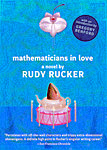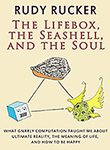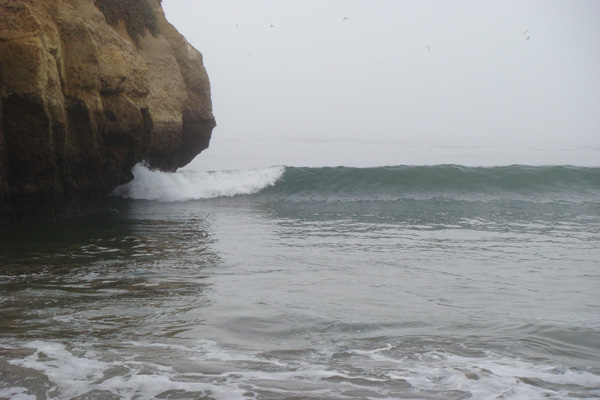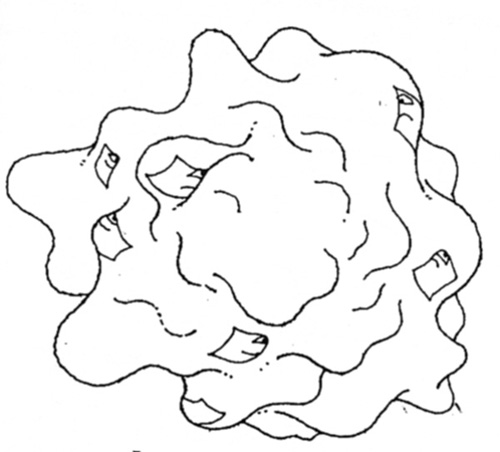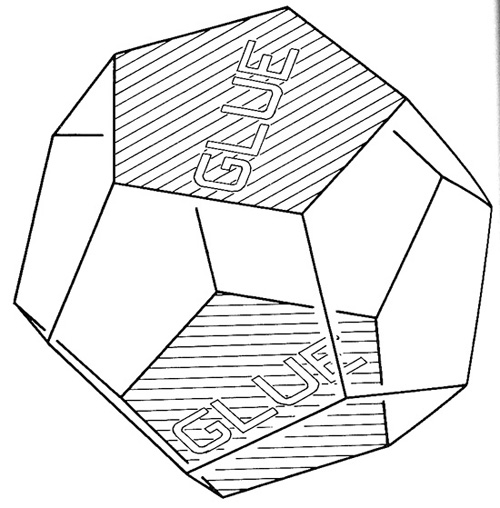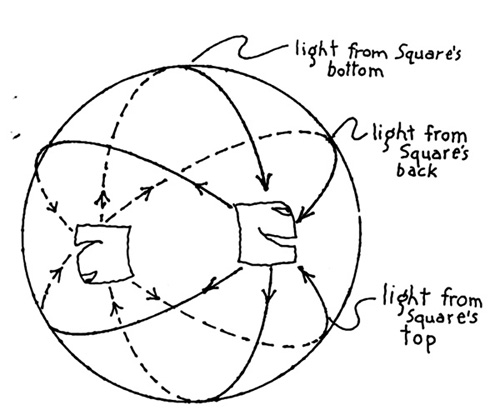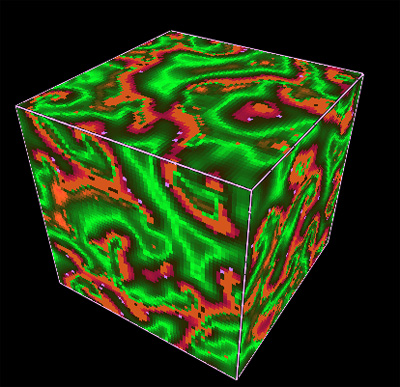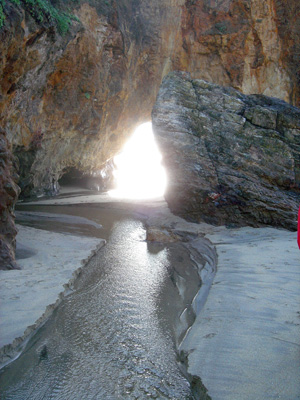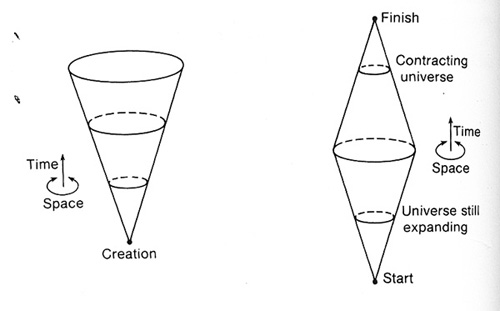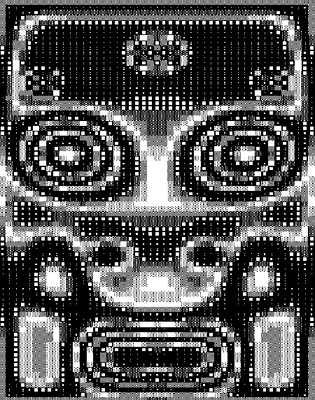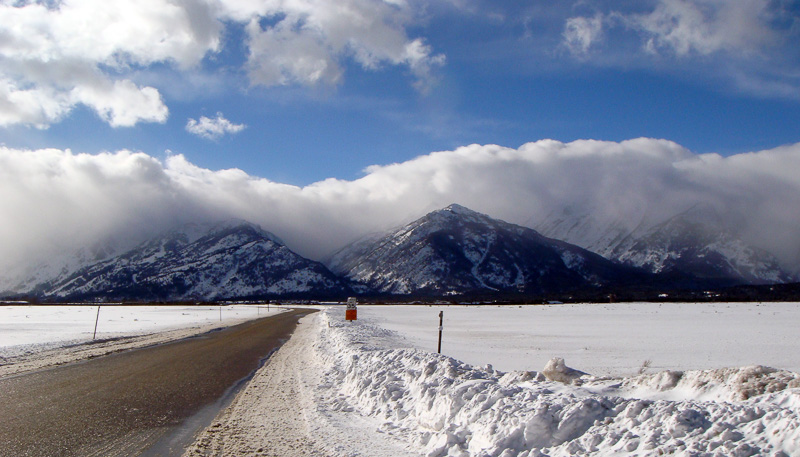
I put some more of my paintings up on Imagekind where you can buy prints of 34 of them and — tada! — you can now buy them as inexpensive greeting cards!
It’s a major hassle getting the pictures into digital form. I reshot some of the older ones too, by the way, to enhance the resolution. I photograph them on high-end slide film with my old “safari model” (i.e. green) Leica R3 single-lens reflex on a tripod, get the film devloped at Superior Color Lab in the Willow Glen neighborhood of San Jose, then send the slides to this nice place, My Special Photos, in Los Altos up the peninsula that scans them at 4,000 dpi to 16-bit deep color TIF files with effectively 24 megapixels per image, using a high-end Nikon scanner.

And then I PhotoShop the hell out of the images to make them pop. Speaking of PhotoShop, I just got CS3 and am playing a little with the HDR (High Dynamic Range) gimmick where you can fuse several images taken at different exposures so as to get better highlights and shadow areas; the image above is made of three exposures. The one below is a better picture, compositionally, using just one exposure, though it’s not all that sharp and maybe I over-PhotoShopped the color. Both shot at Castle Rock Park.

Every step of the way, in turning my paintings into digital files, I’m dogged by uncertainty and worry; the most maddening thing is that at the end of the road, I’ll often feel that the original photo I shot wasn’t as good as it could have been in terms of lighting. Glare is a problem, as is over or under exposure, even when I shoot bracket shots.
In any case, I’ve come to accept that the final colors are more or less arbitrary, with only a casual relation to the original. ‘s all PhotoShoppable. But bad glare or a blown-out negative is hard to compensate for.
My friend Mimi was kidding me about “learning to suffer for my art.” Uploading the 80 megabyte files to Imagekind is a hassle too, I might add, it takes about an hour per file, and doesn’t always work.

I’m feeling a little frazzled these days, as I’ve had a frikkin’ cold for three weeks, which gets depressing. Also I miss the “narcotic moment of creative bliss” that I get from writing. Now and then a photograph gives me a tiny hit. PhotoShop CS3 has this nice FilterDistort|Lens Correction filter that lets you get rid of barrel and keystone distortion in a shot of something rectangular like the frame above. I love neon martini signs.
It would be simpler to shoot my paintings with a heavy-duty SLR digital camera, of course, as then I could right away see what I’d shot, and I wouldn’t have to deal with two separate photo labs. But (a) I don’t have one, and (b) if I did, the current typical 12 megapixel size would be about half of the 24 megapixel I get via the hig-res scan, although it could be that the crispness would be just as good if I was doing it digitally, also I could be sure I got the framing and exposure right. It could well be that the slide to digital conversion puts in more noise than you’d have if you shot straight to digital and just did a resampling to raise the size.

I do love using that old Leica. Actually you can get an adapter to put Leica lenses onto Canon EOS bodies, although then you have to do manual focusing. The lower end bodies are plastic, which I hate the feel of, but you can get a magnesium body Canon 5D for under $2K, or a Canon 1D Mark III with a 20 megabyte sensor for maybe $5K, but that’s really a lot of money to spend on something I might not use that much.
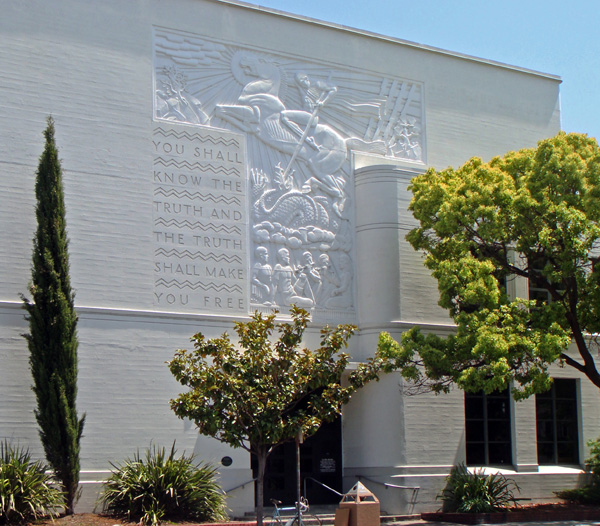
In practice, I really like shooting with my pocket SONY Cybershot 8 Megapixel T100. If I have a camera in my pocket all the time, I get lots of shots, and if I have to put pounds-heavy camera around my neck, I hardly use it. And, after all, mostly I just use my photos for my blog at some really low pixel count, like 2 or 3 megapixels. Of course if I got into selling prints I could open up a whole new world of effort…
Anyway here’s descriptions of the five latest paintings of mine that you can buy prints of.
31. Mossy Trees
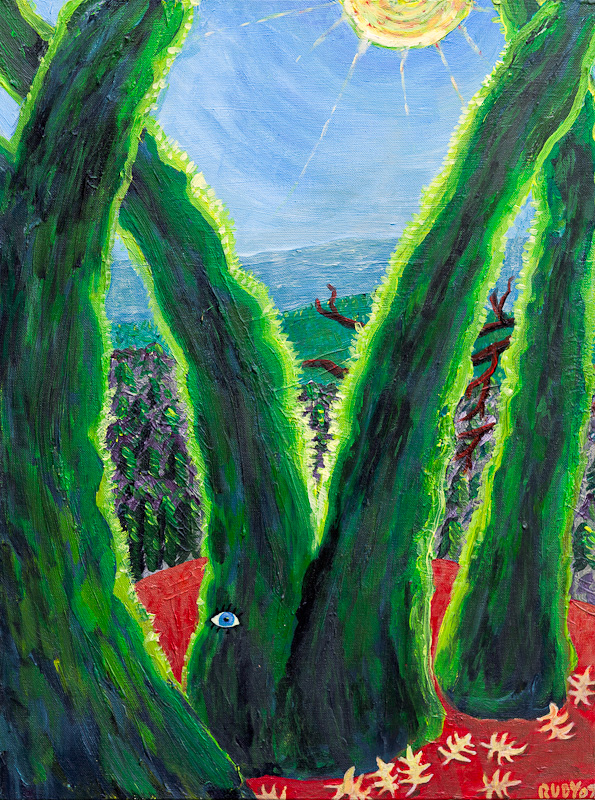
Acrylic on canvas, 18" x 24", November, 2007.
I got into an en plein air thing again in the sunny winter of 2007. I wore a paint stained overcoat and wedged my paints into a knapsack and strapped a canvas to that. It was great to be all covered in paint clothes with a knapsack. I looked like a bum. People looked askance.
On a ridge in the Castle Rock park above Los Gatos and Saratoga I found some trees that were completely covered with fronds of moss. The sun was going down in the west over the Pacific Ocean, edging the mossy trees with brilliant yellow-green. The tree’s a little like a woman’s legs, too, very fertile. To pep up the picture, I added an eye. I like to wrap my paintings around, painting on the edges so I don’t have to frame them. I put another eye on the left edge, though you can’t see it in this image.
It was beautiful here. I was thinking of a drawing by Hieronymus Bosch were he sketches an eye on the ground and an ear on a tree.
32. Giant’s Head

Acrylic on canvas, 18" x 24", December, 2007.
Like “Mossy Trees,” “Giant’s Head” is a painting I started outdoors in Castle Rock Park near Saratoga, California. This particular rock is called California Ridge. I circled around on a narrow ledge to get to this vantage point. I was somewhat worried about falling off, there was a hundred foot drop to the ground. I painted my hand in there, like clutching at the rock to show that I was scared.
The rock itself reminded me of the profile of Homer Simpson. There were a lot of little lichen patches on it, I just tried to suggest those with some spots of color. That white line in the sky is a jet contrail. The green of the trees was really lovely, it felt good being alone up here on the ledge. I didn’t have room to stay very clean and I got a lot of paint on myself.
33. The Muse

Acrylic on canvas, 24" x 18", January, 2008.
My wife was out of town for a week visiting our daughter in New York, and I took my knapsack of paints and a canvas out to a cliff overlooking Four Mile Beach north of Santa Cruz, California. This spire of rock was probably part of a natural bridge many years ago. I often walk along the beach to this spot, it’s usually deserted and very beautiful. You don’t see any sign of human activity in any direction.
This was the first time I’d gotten onto the cliff right above the rock. It was a very windy day, and I found a depression in the cliff, a little grassy dell, and I settle in there. I particularly wanted to get the shape of the long, breaking dark wave near the horizon. A pelican flew past and I got a digital photo of him. I wished my wife were there with me.
When I got home, I kind of had to laugh at the inadequacy of the few daubs of paint I’d made—compared to the joyful, living seascape that I’d been looking at. It’s insane. You’re daubing ground up bits of stone onto a cloth and hoping to capture the physical world. But I did two more layers on the painting and finally I was happy with it.
To liven it up, I printed out a large image of the pelican I’d scene, also an image of my wife, and I slid those images around on the canvas until the composition looked right. And then I outlined those spots and painted copies of the images. I wasn’t sure I could do a human face—and the woman doesn’t really look that much like my wife. I think of her as “The Muse.” When I go out alone in nature, that’s who I’m hoping to hear from: the muse.
34. Spacetime Donuts

Acrylic on paper, 17" x 13", April, 2008.
In April of 2008, I arranged for a small press to reprint two of my early science fiction novels, Spacetime Donuts and The Sex Sphere. As part of the deal, they agreed to let me design the covers.
Spacetime Donuts is about a somewhat punk-like young mathematician who finds a way to shrink down so small that he wraps around the scale axis and gets big. Scale turns out to be circular, and spacetime is in some sense like a donut. I wrote this novel in 1979, and it can be argued that this was one of the very first cyberpunk science-fiction novels. The characters in the book plug their brains into computers, which is why I have that wire coming out of his neck.
He’s wearing an earring that’s a variation on the W.A.S.T.E. symbol in Thomas Pynchon’s novel The Crying of Lot 49. As it turns out, the book’s plot resembles this symbol. I had fun making this image really pop with cadmium red and cadmium yellow.
35. The Sex Sphere
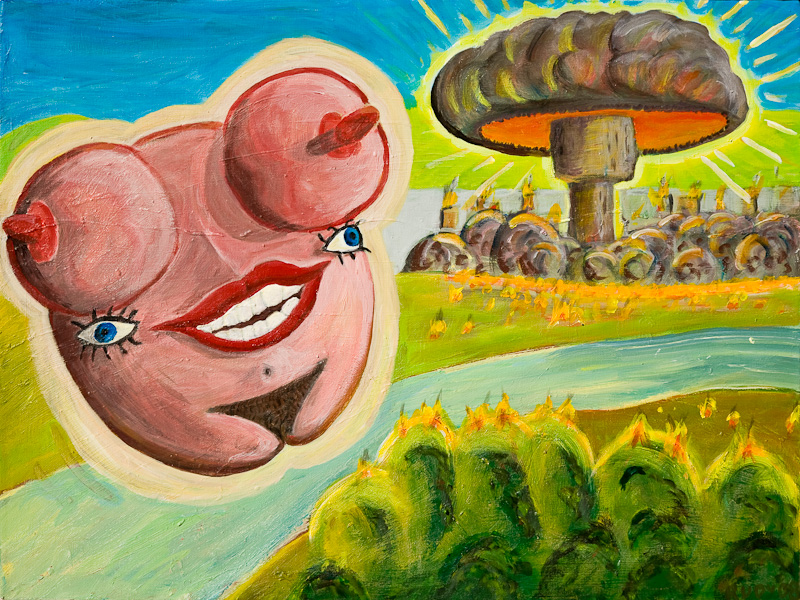
Acrylic on canvas, 14" x 18", April, 20087.
In April of 2008, I arranged for a small press to reprint two of my early science fiction novels, Spacetime Donuts and The Sex Sphere. As part of the deal, they agreed to let me design the covers.
The Sex Sphere is about a being from the fourth dimension named Babs. Her intersection with our 3D space looks like parts of a woman, squeezed together and rounded off. She manipulates some of the characters into setting off a terrorist A-bomb in Florence, Italy. You can see the mushroom cloud in the background. I liked painting this, as it’s so intense and cartoony and surreal. I think the sex sphere looks a little scary.
Originally this painting was going to be a landscape looking out over Silicon Valley. I went up on St. Joseph’s Hill with a canvas and paints and started the picture there with my painter friend Vernon Head. Vernon knows my working habits by now, and he knew something weird was going to show up in the foreground. For awhile I wasn’t sure what it should be, but when I realized I needed a cover image for The Sex Sphere, I was ready to go.

Click here to see an earlier blog description of my first thirty paintings.




